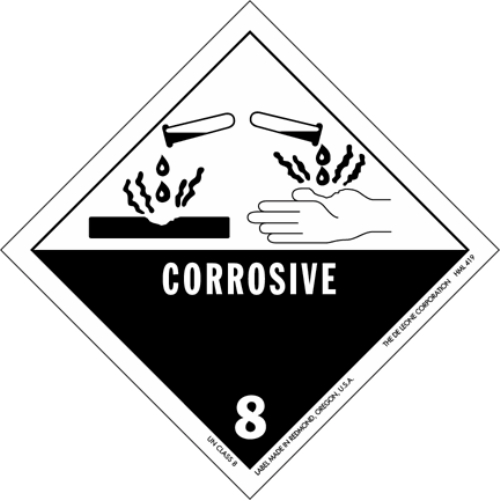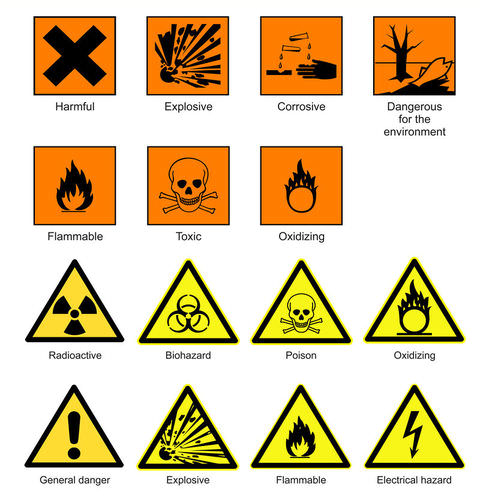1.7: Safety in the Life Sciences
- Page ID
- 12157
\( \newcommand{\vecs}[1]{\overset { \scriptstyle \rightharpoonup} {\mathbf{#1}} } \)
\( \newcommand{\vecd}[1]{\overset{-\!-\!\rightharpoonup}{\vphantom{a}\smash {#1}}} \)
\( \newcommand{\id}{\mathrm{id}}\) \( \newcommand{\Span}{\mathrm{span}}\)
( \newcommand{\kernel}{\mathrm{null}\,}\) \( \newcommand{\range}{\mathrm{range}\,}\)
\( \newcommand{\RealPart}{\mathrm{Re}}\) \( \newcommand{\ImaginaryPart}{\mathrm{Im}}\)
\( \newcommand{\Argument}{\mathrm{Arg}}\) \( \newcommand{\norm}[1]{\| #1 \|}\)
\( \newcommand{\inner}[2]{\langle #1, #2 \rangle}\)
\( \newcommand{\Span}{\mathrm{span}}\)
\( \newcommand{\id}{\mathrm{id}}\)
\( \newcommand{\Span}{\mathrm{span}}\)
\( \newcommand{\kernel}{\mathrm{null}\,}\)
\( \newcommand{\range}{\mathrm{range}\,}\)
\( \newcommand{\RealPart}{\mathrm{Re}}\)
\( \newcommand{\ImaginaryPart}{\mathrm{Im}}\)
\( \newcommand{\Argument}{\mathrm{Arg}}\)
\( \newcommand{\norm}[1]{\| #1 \|}\)
\( \newcommand{\inner}[2]{\langle #1, #2 \rangle}\)
\( \newcommand{\Span}{\mathrm{span}}\) \( \newcommand{\AA}{\unicode[.8,0]{x212B}}\)
\( \newcommand{\vectorA}[1]{\vec{#1}} % arrow\)
\( \newcommand{\vectorAt}[1]{\vec{\text{#1}}} % arrow\)
\( \newcommand{\vectorB}[1]{\overset { \scriptstyle \rightharpoonup} {\mathbf{#1}} } \)
\( \newcommand{\vectorC}[1]{\textbf{#1}} \)
\( \newcommand{\vectorD}[1]{\overrightarrow{#1}} \)
\( \newcommand{\vectorDt}[1]{\overrightarrow{\text{#1}}} \)
\( \newcommand{\vectE}[1]{\overset{-\!-\!\rightharpoonup}{\vphantom{a}\smash{\mathbf {#1}}}} \)
\( \newcommand{\vecs}[1]{\overset { \scriptstyle \rightharpoonup} {\mathbf{#1}} } \)
\( \newcommand{\vecd}[1]{\overset{-\!-\!\rightharpoonup}{\vphantom{a}\smash {#1}}} \)
\(\newcommand{\avec}{\mathbf a}\) \(\newcommand{\bvec}{\mathbf b}\) \(\newcommand{\cvec}{\mathbf c}\) \(\newcommand{\dvec}{\mathbf d}\) \(\newcommand{\dtil}{\widetilde{\mathbf d}}\) \(\newcommand{\evec}{\mathbf e}\) \(\newcommand{\fvec}{\mathbf f}\) \(\newcommand{\nvec}{\mathbf n}\) \(\newcommand{\pvec}{\mathbf p}\) \(\newcommand{\qvec}{\mathbf q}\) \(\newcommand{\svec}{\mathbf s}\) \(\newcommand{\tvec}{\mathbf t}\) \(\newcommand{\uvec}{\mathbf u}\) \(\newcommand{\vvec}{\mathbf v}\) \(\newcommand{\wvec}{\mathbf w}\) \(\newcommand{\xvec}{\mathbf x}\) \(\newcommand{\yvec}{\mathbf y}\) \(\newcommand{\zvec}{\mathbf z}\) \(\newcommand{\rvec}{\mathbf r}\) \(\newcommand{\mvec}{\mathbf m}\) \(\newcommand{\zerovec}{\mathbf 0}\) \(\newcommand{\onevec}{\mathbf 1}\) \(\newcommand{\real}{\mathbb R}\) \(\newcommand{\twovec}[2]{\left[\begin{array}{r}#1 \\ #2 \end{array}\right]}\) \(\newcommand{\ctwovec}[2]{\left[\begin{array}{c}#1 \\ #2 \end{array}\right]}\) \(\newcommand{\threevec}[3]{\left[\begin{array}{r}#1 \\ #2 \\ #3 \end{array}\right]}\) \(\newcommand{\cthreevec}[3]{\left[\begin{array}{c}#1 \\ #2 \\ #3 \end{array}\right]}\) \(\newcommand{\fourvec}[4]{\left[\begin{array}{r}#1 \\ #2 \\ #3 \\ #4 \end{array}\right]}\) \(\newcommand{\cfourvec}[4]{\left[\begin{array}{c}#1 \\ #2 \\ #3 \\ #4 \end{array}\right]}\) \(\newcommand{\fivevec}[5]{\left[\begin{array}{r}#1 \\ #2 \\ #3 \\ #4 \\ #5 \\ \end{array}\right]}\) \(\newcommand{\cfivevec}[5]{\left[\begin{array}{c}#1 \\ #2 \\ #3 \\ #4 \\ #5 \\ \end{array}\right]}\) \(\newcommand{\mattwo}[4]{\left[\begin{array}{rr}#1 \amp #2 \\ #3 \amp #4 \\ \end{array}\right]}\) \(\newcommand{\laspan}[1]{\text{Span}\{#1\}}\) \(\newcommand{\bcal}{\cal B}\) \(\newcommand{\ccal}{\cal C}\) \(\newcommand{\scal}{\cal S}\) \(\newcommand{\wcal}{\cal W}\) \(\newcommand{\ecal}{\cal E}\) \(\newcommand{\coords}[2]{\left\{#1\right\}_{#2}}\) \(\newcommand{\gray}[1]{\color{gray}{#1}}\) \(\newcommand{\lgray}[1]{\color{lightgray}{#1}}\) \(\newcommand{\rank}{\operatorname{rank}}\) \(\newcommand{\row}{\text{Row}}\) \(\newcommand{\col}{\text{Col}}\) \(\renewcommand{\row}{\text{Row}}\) \(\newcommand{\nul}{\text{Nul}}\) \(\newcommand{\var}{\text{Var}}\) \(\newcommand{\corr}{\text{corr}}\) \(\newcommand{\len}[1]{\left|#1\right|}\) \(\newcommand{\bbar}{\overline{\bvec}}\) \(\newcommand{\bhat}{\widehat{\bvec}}\) \(\newcommand{\bperp}{\bvec^\perp}\) \(\newcommand{\xhat}{\widehat{\xvec}}\) \(\newcommand{\vhat}{\widehat{\vvec}}\) \(\newcommand{\uhat}{\widehat{\uvec}}\) \(\newcommand{\what}{\widehat{\wvec}}\) \(\newcommand{\Sighat}{\widehat{\Sigma}}\) \(\newcommand{\lt}{<}\) \(\newcommand{\gt}{>}\) \(\newcommand{\amp}{&}\) \(\definecolor{fillinmathshade}{gray}{0.9}\)
What does this sign mean?
If a substance is corrosive, it can eat through objects. Many scientists have to work with chemicals that are corrosive or otherwise dangerous. That's one reason that following safety precautions in the laboratory or field is very important.
Safety in the Life Sciences
There can be some very serious safety risks in scientific research. If researchers are not careful, they could poison themselves or contract a deadly illness. The kinds of risks that scientists face depend on the kind of research they perform. For example, a scientist working with bacteria in a laboratory faces different risks than a scientist studying the behavior of lions in Africa, but both scientists must still follow safety guidelines. Safety practices must be followed when working with the hazardous things such as parasites, radiation and radioactive materials, toxins, and wild animals. Also, carcinogens, which are chemical that cause cancer, pathogens, which are disease-causing virus, bacteria or fungi, and teratogens, which are chemical that cause deformities in developing embryos, are extremely hazardous, and extreme care must be used when working with these items as well. For example, scientists studying dangerous organisms such as Yersinia pestis, the cause of bubonic plague, use special equipment that helps keep the organism from escaping the lab.
A biohazard is any biological material that could make someone sick, including disease-causing organisms. Therefore, a used needle is a biohazard because it could harbor blood contaminated with a disease-causing organism. Bacteria grown in a laboratory are also biohazards if they could potentially cause disease.

Laboratory Safety
If you perform an experiment in your classroom, your teacher will explain how to be safe. Professional scientists follow safety rules as well, especially for the study of dangerous organisms like the bacteria that cause bubonic plague (Figure below).
Sharp objects, chemicals, heat, and electricity are all used at times in laboratories. Below is a list of safety guidelines that you should follow when in the laboratory:
- Be sure to obey all safety guidelines given in lab instructions and by your teacher.
- Follow directions carefully.
- Tie back long hair.
- Wear closed toe shoes with flat heels and shirts with no hanging sleeves, hoods, or drawstrings.
- Use gloves, goggles, or safety aprons when instructed to do so.
- Broken glass should only be cleaned up with a dust pan and broom. Never touch broken glass with your bare hands.
- Never eat or drink anything in the science lab. Table tops and counters could have dangerous substances on them.
- Be sure to completely clean materials like test tubes and beakers. Leftover substances could interact with other substances in future experiments.
- If you are using flames or heat plates, be careful when you reach. Be sure your arms and hair are kept far away from heat.
- Alert your teacher immediately if anything out of the ordinary occurs. An accident report may be required if someone is hurt. Also, the teacher must know if any materials are damaged or discarded.

Field Research Safety
A field scientist studies an organism in a natural setting, which is not usually an indoor laboratory. Scientists who work outdoors are also required to follow safety regulations. These safety regulations are designed to prevent harm to themselves, other humans, animals, and the environment. If scientists work outside the country, they are required to learn about and follow the laws and restrictions of the country in which they are doing research. For example, entomologists following monarch butterfly (Figure below) migrations between the United States and Mexico must follow regulations in both countries. Before biologists can study protected wildlife or plant species, they must apply for permission to do so, usually from the government. This is important to protect these fragile species. For example, if scientists collect rare butterflies, they must first get a permit. They must also be careful to not disturb the habitat.

Summary
- There are serious risks in scientific research, including carcinogens, biohazards, and toxins.
- You need to carefully follow all safety rules while working in the laboratory.
Explore More
Use the resources below to answer the questions that follow.
Explore More I
- FSU Chemistry Lab Safety at http://www.youtube.com/watch?v=hv9imJzZWrY (6:51)
- Is applying cosmetics in a lab allowed?
- What should you do if there is an accident?
- How should you dispose of waste?
Explore More II
- Science Lab Safety Rules at http://www.youtube.com/watch?v=yclOrqEv7kw (2:24)
- List five lab safety rules covered in the video.
- What kind of clothing should you wear in a science lab?
- What should you wear in a science lab that you would not usually wear outside of a science lab?
Review
- What is a biohazard?
- List three hazards found in scientific research.
- List three safety guidelines that you should follow in the laboratory.

